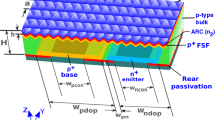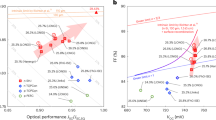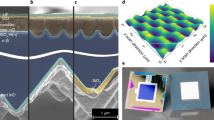Abstract
Silicon nanowire and nanopore arrays promise to reduce manufacturing costs and increase the power conversion efficiency of photovoltaic devices. So far, however, photovoltaic cells based on nanostructured silicon exhibit lower power conversion efficiencies than conventional cells due to the enhanced photocarrier recombination associated with the nanostructures. Here, we identify and separately measure surface recombination and Auger recombination in wafer-based nanostructured silicon solar cells. By identifying the regimes of junction doping concentration in which each mechanism dominates, we were able to design and fabricate an independently confirmed 18.2%-efficient nanostructured ‘black-silicon’ cell that does not need the antireflection coating layer(s) normally required to reach a comparable performance level. Our results suggest design rules for efficient high-surface-area solar cells with nano- and microstructured semiconductor absorbers.
This is a preview of subscription content, access via your institution
Access options
Subscribe to this journal
Receive 12 print issues and online access
$259.00 per year
only $21.58 per issue
Buy this article
- Purchase on Springer Link
- Instant access to full article PDF
Prices may be subject to local taxes which are calculated during checkout





Similar content being viewed by others
References
Stephens, R. B. & Cody, G. D. Optical reflectance and transmission of a textured surface. Thin Solid Films 45, 19–29 (1977).
Koynov, S., Brandt, M. S. & Stutzmann, M. Black nonreflecting silicon surfaces for solar cells. Appl. Phys. Lett. 88, 203107 (2006).
Branz, H. M. et al. Nanostructured black silicon and the optical reflectance of graded-density surfaces. Appl. Phys. Lett. 94, 231121 (2009).
Garnett, E. & Yang, P. D. Light trapping in silicon nanowire solar cells. Nano Lett. 10, 1082–1087 (2010).
Kelzenberg, M. D. et al. Enhanced absorption and carrier collection in Si wire arrays for photovoltaic application. Nature Mater. 9, 239–244 (2010).
Han, S. E. & Chen, G. Optical absorption enhancement in silicon nanohole arrays for solar photovoltaics. Nano Lett. 10, 1012–1015 (2010).
Branz, H. M. et al. Hot-wire chemical vapor deposition of epitaxial film crystal silicon for photovoltaics. Thin Solid Films 519, 4545–4550 (2011).
Tian, B. Z. et al. Coaxial silicon nanowires as solar cells and nanoelectronic power sources. Nature 449, 885–888 (2007).
Weisse, J. M., Kim, D. R., Lee, C. H. & Zheng, X. L. Vertical transfer of uniform silicon nanowire arrays via crack formation. Nano Lett. 11, 1300–1305 (2011).
Boettcher, S. W. et al. Energy-conversion properties of vapor-liquid-solid-grown silicon wire-array photocathodes. Science 327, 185–187 (2010).
Putnam, M. C. et al. Si microwire-array solar cells. Energy Environ. Sci. 3, 1037–1041 (2010).
Garnett, E. C. & Yang, P. D. Silicon nanowire radial p–n junction solar cells. J. Am. Chem. Soc. 130, 9224–9225 (2008).
Yuan, H. C. et al. Efficient black silicon solar cell with a density-graded nanoporous surface: optical properties, performance limitations, and design rules. Appl. Phys. Lett. 95, 123501 (2009).
Peng, K. Q. et al. Aligned single-crystalline Si nanowire arrays for photovoltaic applications. Small 1, 1062–1067 (2005).
Sai, H. et al. Wide-angle antireflection effect of subwavelength structures for solar cells. Jpn. J. Appl. Phys. 46, 3333–3336 (2007).
Yoo, J., Yu, G. & Yi, J. Black surface structures for crystalline silicon solar cells. Mater. Sci. Eng. B 159–160, 333–337 (2009).
Her, T. H. et al. Microstructuring of silicon with femtosecond laser pulses. Appl. Phys. Lett. 73, 1673–1675 (1998).
Toor, F. et al. Multi-scale surface texture to improve blue response of nanoporous black silicon solar cells. Appl. Phys. Lett. 99, 1030501 (2011).
Garnett, E. C., Brongersma, M. L., Cui, Y. & McGehee, M. D. Nanowire solar cells. Annu. Rev. Mater. Res. 41, 269–295 (2011).
Kayes, B. M., Atwater, H. A. & Lewis, N. S. Comparison of the device physics principles of planar and radial p–n junction nanorod solar cells. J. Appl. Phys. 97, 114302–114311 (2005).
Koren, E. et al. Nonuniform doping distribution along silicon nanowires measured by Kelvin probe force microscopy and scanning photocurrent microscopy. Appl. Phys. Lett. 95, 092105 (2009).
Aberle, A. G. Crystalline Silicon Solar Cells: Advanced Surface Passivation and Analysis (Centre for Photovoltaic Engineering, University of New South Wales, 1999).
Green, M. A. Solar Cells: Operating Principles, Technology, and System Applications (Prentice-Hall, 1982).
King, R. R., Sinton, R. A. & Swanson, R. M. Studies of diffused phosphorus emitters—saturation current, surface recombination velocity, and quantum efficiency. IEEE Trans. Electron. Dev. 37, 365–371 (1990).
Cuevas, A., Basore, P. A., Giroult-Matlakowski, G. & Dubois, C. Surface recombination velocity of highly doped n-type silicon. J. Appl. Phys. 80, 3370–3375 (1996).
Huang, Z. P. et al. Metal-assisted chemical etching of silicon: a review. Adv. Mater. 23, 285–308 (2011).
Kao, D-B., McVittie, J. P., Nix, W. D. & Saraswat, K. C. Two-dimensional thermal oxidation of silicon-I. Experiments. IEEE Trans. Electron. Dev. 34, 1008–1017 (1987).
Liu, H. I. et al. Self-limiting oxidation for fabricating sub-5 nm silicon nanowires. Appl. Phys. Lett. 64, 1383–1385 (1994).
Acknowledgements
The authors thank B. To of NREL for assistance with SEM. The authors are grateful to F. Toor and M.R. Page of NREL for many helpful discussions and T. Buonassissi of MIT for important insight into the role of Auger recombination. This work was supported by a DOE American Recovery and Reinvestment Act (ARRA) Photovoltaic Supply Chain and Crosscutting Technologies grant (contract no. DE-AC36-08GO28308).
Author information
Authors and Affiliations
Contributions
J.O. conceived and designed the study to answer the questions posed jointly by J.O., H-C.Y. and H.M.B. J.O. performed the experiments and analysed the data. J.O. and H.M.B. co-wrote the paper. All authors discussed the results and improved the manuscript.
Corresponding author
Ethics declarations
Competing interests
The authors declare no competing financial interests.
Supplementary information
Supplementary information
Supplementary information (PDF 377 kb)
Rights and permissions
About this article
Cite this article
Oh, J., Yuan, HC. & Branz, H. An 18.2%-efficient black-silicon solar cell achieved through control of carrier recombination in nanostructures. Nature Nanotech 7, 743–748 (2012). https://doi.org/10.1038/nnano.2012.166
Received:
Accepted:
Published:
Issue Date:
DOI: https://doi.org/10.1038/nnano.2012.166
This article is cited by
-
The impact of plasmonic electrodes on the photocarrier extraction of inverted organic bulk heterojunction solar cells
Applied Physics A (2023)
-
Influence of Low Molarity Hafnium Synthesis on the Reflection Properties of Polished and Textured Crystalline Silicon Substrates Coated with HfO2 Thin Films
Silicon (2023)
-
The final stage of droplet evaporation on black silicon by schlieren technique with a graded filter
Experiments in Fluids (2023)
-
Optical properties of periodically and aperiodically nanostructured p-n junctions
Optical and Quantum Electronics (2023)
-
Effect of thermal annealing on the structural and optical properties of black silicon
Journal of Materials Science: Materials in Electronics (2022)



